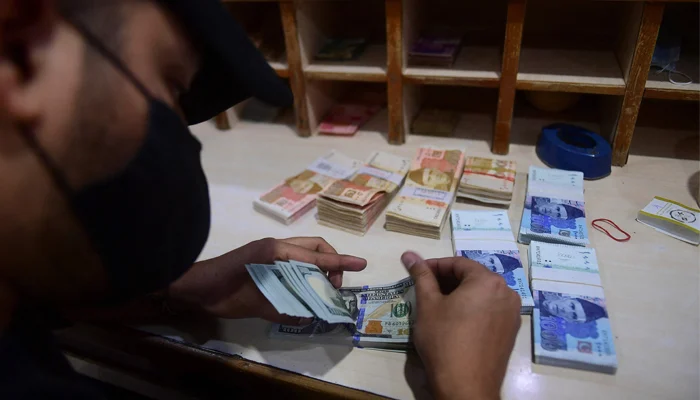- ECAP believes the move will place curbs on illegal channels.
- Says it will eventually eliminate the prevailing grey market.
- Rupee in the grey market has reached 267/270 against the dollar.
KARACHI: The Exchange Companies Association of Pakistan (ECAP) has advised the government to “fix” the dollar rate to reduce the volatility in the currency market as the country grapples with a severe economic crisis amid depleting forex reserves, reported The News.
“It is advised to fix the rupee/dollar exchange rate for export-import bills and remittances,” said Zafar Paracha, the general secretary of ECAP in a statement on Monday. These remittance proceeds could be brought in by banks and money changers at a fixed rate of 240 per dollar, he added.
The local currency ended at 228.34 per dollar, compared with the previous close of 228.15 in the interbank market. In the open market, the rupee was trading at 238.75 against the dollar. It was available at 238.50 on Friday.
Paracha suggested to the government to offer a rate of Rs240 per dollar to overseas Pakistanis and for inward remittance. He believes the move would help increase remittances, reduce Hundi/Hawala, strengthen the official channel, and eventually eliminate the grey market.
The rate of the dollar in the grey market has reached 267/270 versus the local unit, according to Paracha. For the purpose of getting the exporters’ proceeds, the offer could be made at 228 rupees to the dollar. And the rate for importers would be based on the weighted average of home remittance and exporter rates. It would benefit exporters and remittances, he explained.
“It will encourage exporters to bring dollars into the country, enhance the foreign exchange reserve, and strengthen the remittances segment of the exchange firms.”
Remittances from Pakistanis working abroad dropped 19% to $2.0 billion in December.
During the first six months (July-December) of the current fiscal year, the nation received $14.1 billion in remittances, which is a decrease of 11.1% from a year earlier.
Pakistan’s forex reserves held with the State Bank of Pakistan dropped by $1.2 billion to $4.3 billion as of January 6 — enough to cover barely three weeks’ worth of imports.
The country is currently experiencing a balance of payments crisis due to large foreign debt repayments and a lack of external finance, which have severely depleted Pakistan’s foreign reserves and led to persistent dollar shortages.
The government has restricted several imports to save dollars, and some businesses have shut down as a result of being unable to import machinery or parts.

 Latest News13 hours ago
Latest News13 hours ago
 Latest News13 hours ago
Latest News13 hours ago
 Latest News12 hours ago
Latest News12 hours ago
 Latest News12 hours ago
Latest News12 hours ago
 Latest News13 hours ago
Latest News13 hours ago
 Business13 hours ago
Business13 hours ago
 Latest News13 hours ago
Latest News13 hours ago
 Latest News13 hours ago
Latest News13 hours ago





















